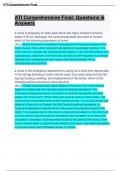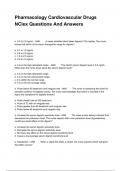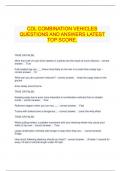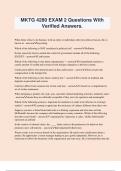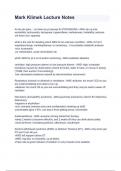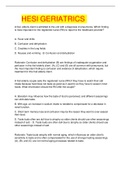ATI Comprehensive Final : Questions & Answers a nurse is preparing an older adult client who had a transient ischemic attack (TIA) for discharge. the nurse should teach the client to monitor which of the following parameters at home (Ans - Blood pressure A temporary disturbance of the blood supply to the brain causes TIAs, which are brief alterations in neurologic function. The most common causes are atherosclerotic plaque in the carotid arteries and hypertension; therefore, the client sho uld track his BP regularly to promote hypertension management and reduce the risk of another TIA or cerebrovascular accident. a nurse in the emergency department is caring for a client who reports pain in her left leg following a motor -vehicle crash. the nurse notes that her left leg has bruising, swelling, and displacement of the bones. which of the following actions should the nurse take first (Ans - Check neurovascular status distal to the injury The nurse should apply the safety and risk reduction priority -setting framework. This framework assigns priority to the factor or situation posing the greatest safety risk to the client. When there are seve ral risks to client safety, the one posing the greatest threat is the highest priority. The nurse should use Maslow's Hierarchy of Needs, the ABC priority -setting framework, or nursing knowledge to identify which risk poses the greatest threat to the client. The greatest risk to this client is impaired circulation to the limb from trauma and the resulting edema; therefore, the first action is to check the circulation, sensation, and movement distal to the level of the injury. If the nurse notes a weak or ab sent pulse distal to the injury, the limb's circulation is compromised, and immediate action is critical. ATI Comprehensive Final A nurse is teaching the parent of a child who has type 1 diabetes mellitus how to manage the child's disorder during illness, such as colds. Which of the following statements by the parent indicates an understanding of the teaching? (Ans - "I'll check his blood glucose more often." The parent should check the child's blood glucose every 3 hr during an illness because it tends to rise, even if the child eats less food. A nurse is caring for a client who has a platelet count of 50,000/mm3. After discontinuing the client's peripheral IV site, which of the following actions should the nurse take? (Ans - Apply pressure to the catheter removal site for 5 minutes. A platelet count below 100,000/mm3 indicates thrombocytopenia, a problem that puts the client at increased risk for bleeding. By applying pressure to the site for at least 5 min, the nurse promotes coagulation and prevents additional blood loss. A nurse is assessing a 66 -year-old client during a routine physical examination at her first clinic visit and does not have her medical records. When the nurse asks if she has received the pneumococcal immunization, the client replies, "I am not sure, but it's been at least 5 years since I had any immunizations." Which of the following responses should the nurse make? (Ans - "Let's go ahead with giving you this immunization." The Centers for Disease Control and Prevention recommends this immunization for people who are 65 years old and older. If the client did receive this immunization more than 5 years ago, the nurse should administer another one because the client is over 65. A nurse is monitoring the electrocardiogram of a client who has hypocalcemia. Which of the following findings should the nurse expect? (Ans - Prolonged Q -T intervals Manifestations of hypocalcemia include tingling, numbness, tetany, seizures, prolonged Q -T intervals, and laryngospasm. Causes include hypoparathyroidism, chronic kidney disease, and diarrhea. A nurse is providing discharge teaching to a client who has had a TIA. Which of the following instructions should the nurse include? (Ans - Reduce dietary sodium. A temporary disturbance of the blood supply to the brain causes TIAs, which are brief alterations in neurologic function. The most common causes are atherosclerotic plaque in the carotid arteries and hypertension; therefore, the clie nt should limit sodium intake to help control hypertension and prevent future TIAs. A nurse is reviewing the laboratory report for a client who has chronic kidney disease (CKD). The nurse finds the following laboratory test results: potassium 6.8 mEq/L, calcium 7.4 mg/dL, hemoglobin 10.2 g/dL, and phosphate 4.8 mg/dL. Which of the followi ng findings is the priority for the nurse to report to the provider? (Ans - Hyperkalemia The nurse should apply the urgent versus nonurgent priority -setting framework when caring for this client. Using this framework, the nurse should consider urgent needs the priority need because they pose more of a threat to the client. The nur se may also need to use Maslow's hierarchy of needs, the ABC priority -setting framework, or nursing knowledge to identify which finding is the most urgent. Therefore, hyperkalemia, which can cause life -threatening cardiac dysrhythmias, is the priority for the nurse to report to the provider. A nurse is caring for a client who has dehydration and has developed hypovolemic shock. Which of the following laboratory values should the nurse expect for the client? (Ans - Hct 55% An elevated hematocrit indicates hypovolemia. Other indications of hypovolemia are a weak pulse, tachycardia, hypotension, tachypnea, slow capillary refill, elevated BUN, increased urine specific gravity, and decreased urine output. A client at a routine prenatal care visit asks the nurse if it is common to develop vaginal yeast infections during pregnancy. Which of the following responses should the nurse make? (Ans - "The hormonal changes of pregnancy change the acidity of the vagina, making yeast infections more common." This is an information -seeking question; therefore, the therapeutic response is an answer that provides the client with the information she requested. A nurse is assessing a school -age child who has celiac disease. Which of the following findings should the nurse expect? (Ans - Steatorrhea. Foul, fatty, frothy stools, known as steatorrhea, are a manifestation of celiac disease, a malabsorption syndrome. A nurse is caring for a client who is receiving mechanical ventilation and develops acute respiratory distress. Which of the following actions should the nurse take first? (Ans - Initiate bag -valve -mask ventilation. The nurse should apply the ABC priority -setting framework when caring for this client. This framework emphasizes the basic core of human functioning - having an open airway, being able to breathe in adequate amounts of oxygen, and circulating oxygen to the body's organs via the blood. An alteration in any of these can indicate a threat to life, and is therefore, the nurse's priority concern. When applying the ABC priority -setting framework, airway is always the highest priority because the airway must be clear and open for oxygen exchange to occur. Breathing is the second -highest priority in the ABC priority -setting framework because adequate ventilatory effort is essential in order for oxygen exchange to occur. Circulati on is the third -highest priority in the ABC priority -setting framework because delivery of oxygen to critical organs only occurs if the heart and blood vessels are capable of efficiently carrying oxygen to them. Therefore, the nurse should first provide ventilations with a bag -valve mask device. A nurse is assessing a client who is taking varenicline for smoking cessation. Which of the following findings is nurse's priority? (Ans - Mood changes. The nurse should apply the safety and risk reduction priority -setting framework. This framework assigns priority to the factor or

